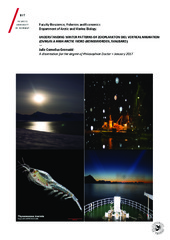Understanding winter patterns of zooplankton Diel Vertical Migration (DVM) in a high Arctic fjord (Kongsfjorden, Svalbard)
Permanent lenke
https://hdl.handle.net/10037/10964Åpne
Thesis (PDF)
Paper III: Cohen, J. H., Berge, J., Moline, M. A., Sørensen, A. J., Last, K., Falk-Petersen, S., Renaud, P. E., Leu, E. S., Grenvald, J. C., Cottier, F., Cronin, H., Menze, S., Norgren, P., Varpe, Ø., Daase, M., Darnis, G., Johnsen, G.: “Is ambient light during the high Arctic polar night sufficient to act as a visual cue for zooplankton?” Also available in PLoS ONE 2015, 10 (6): e0126247. (PDF)
Paper IV: Darnis, G., Hobbs, L., Geoffroy, M., Grenvald, J. C., Renaud, P., Berge, J., Cottier, F., Kristiansen, S., Daase, M., Søreide, J., Wold, A., Morata, N., Gabrielsen, T. M.: “From polar night to midnight sun: diel vertical migration, metabolism and biogeochemical role of zooplankton in a high Arctic fjord (Kongsfjorden, Svalbard)». Also available in Limnology and Oceanography 2017. (PDF)
Dato
2017-05-09Type
Doctoral thesisDoktorgradsavhandling
Forfatter
Grenvald, Julie CorneliusSammendrag
Recent Arctic studies contradict a long-held paradigm of winter quiescence by documenting activity at many trophic levels in the marine food web even during the darkest months of winter. Previous studies have failed to identify which species are performing patterns of vertical migrations during polar night in Kongsfjorden (Svalbard). In the present study, acoustic data supplemented by zooplankton net sampling demonstrated that polar night migration involved several migration patterns. Synchronized diel vertical migration (DVM) was present during the first and final parts of the polar night period, when day-night cycles were more distinct. During the darkest months of mid-winter, synchronized DVM was absent. Mid-winter migration patterns were restricted to surface waters, of unsynchronized character, and did not follow a clear diurnal pattern. Periodically, mid-winter migrations became more synchronized possibly due to enhanced light sources other than solar, such as lunar light. Copepods, chaetognaths and krill (Thysanoessa spp.) were abundant species but krill were responsible for the acoustic migration patterns. Spectral sensitivity tests showed that krill (T. inermis) were able to perceive solar background illumination during mid-winter. A clock gene investigated in krill required light to show circadian rhythmicity. The molecular and electrophysiological experiments suggested that polar night migration was exogenous governed by ambient light levels rather than endogenously controlled, although, light intensity had to be at a certain threshold to show diurnal rhythms. Light levels were probably too low during mid-winter, which explains unsynchronized migration patterns and lack of clock gene rhythms. Predation pressure was not evaluated in the present study but it may be that the ultimate driver for synchronized migration patterns was an anti-predatory response. This study presents a very first glimpse into a biosphere in which the dominant light source appears to trigger a response in zooplankton species, which does not always follow a diurnal pattern.
Beskrivelse
The papers I and II of this thesis are not available in Munin.
Paper I: Grenvald, J. C., Callesen, T. A., Daase, M., Hobbs, L., Darnis, G., Renaud, P., Cottier, F., Nielsen, T. G., Berge, J.: “Plankton community composition and vertical migration during polar night in Kongsfjorden”. Available in Polar Biology 2016, 39(10): 1879–1895.
Paper II: Grenvald, J. C., Vader, A., Reinardy, H., Berge, J., Renaud, P., Gabrielsen, T. M.: “Does the cryptochrome 2 gene (cry2) act as a circadian clock gene in krill (Thysanoessa spp.) during polar night in Kongsfjorden (Svalbard)? (Manuscript).
Forlag
UiT The Arctic University of NorwayUiT Norges arktiske universitet
Metadata
Vis full innførselSamlinger
Copyright 2017 The Author(s)
Følgende lisensfil er knyttet til denne innførselen:


 English
English norsk
norsk
